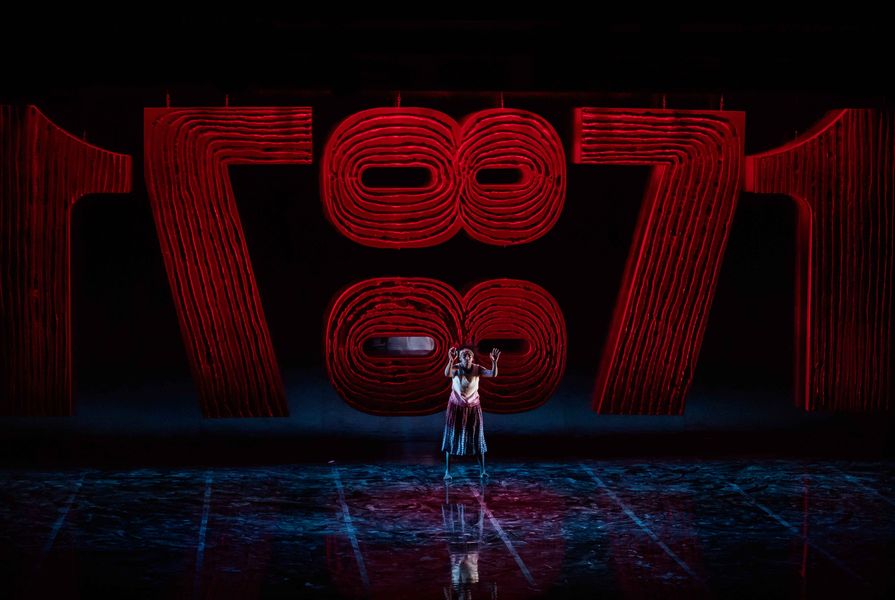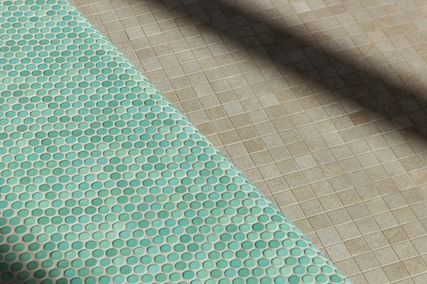Jacob Nash has spent the last 12 years as head of design at Bangarra Dance Theatre – an Aboriginal and Torres Strait Islander dance company centred on the First Nations stories through the medium of contemporary dance. Nash – a descendent of the Daly River people, West of Darwin – contributes to the telling of stories through authentic set design following a meticulous exploration of place and history.
In 2018, Nash was awarded a Helpmann Award for Best Scenic Design for his set design in Bennelong, lauded for its “ravishingly beautiful and deeply unsettling” realization of First Nations history, through design, dance and an immersive soundscape.
Today, Nash is Sydney Art Festival’s creative artist-in-residence and co-ordinator of the festival’s Blak Out program, as well as on the board of directors for the Belvoir Street Theatre. He talks to ArchitectureAU about the ingredients for creating a meaningful world within the three walls of the stage.
Bennelong, Bangarra Theatre Company.
Image: Jacob Nash
AAU: How did you come to find yourself in set design?
Jacob Nash: I fell into it, I guess you could say. Mum and Dad were both art teachers and I studied visual art. I knew I wanted to tell stories somehow, but I didn’t know how.
I saw a Bangarra show in Sydney in 2002, and I just thought, “Oh my god, this is me.” It connected all the different things I loved in a contemporary expression of culture that I’d never experienced before. I think, for lots of people who’ve worked at Bangarra, there’s this moment where you feel so inspired and proud; it’s a wave of magic that fills you up.
I also happened to be at NIDA (National Institute of Dramatic Art) design school as a visitor when they had their design exhibition on for the graduating students around that time. Those two things came together, and I applied to go to school there in September.
AAU: Was dance a medium through which you have always found meaning?
JN: No. But I knew I never want[ed] to paint a perfect replica of whatever was in front of me. I wanted to find its spirit – find something out about it that you couldn’t see. Bangarra does all of those things. It’s dance theatre: it’s this magic space between storytelling and letting an audience dream. It’s all the elements coming together that gives you an experience that makes you think. “Abstract” isn’t the right word, but it’s the space between what you hear and what you see that, as an audience member, you fill out, and that’s what design does at Bangarra.
Dark Emu, Bangarra Theatre Company.
Image: Jacob Nash
AAU: Bangarra’s productions focus on a connection to the land. How do you represent land and its history using metaphor, symbolism and allegory?
JN: Every single story we tell comes from Country and the people that live on that land. You have to stand in those places with those families and absorb and listen in order to work out how you can respond in a truthful manner to the place you’re in. It takes time to discover what that language is.
For example, we did Terrain in 2012 with choreographer Frances Rings. [Prior to designing the stage], we went out on a trip to Lake Eyre [where the story is set]. We all got out of the car and we just stood in the silence. But it wasn’t silence – there was so much stillness, it was like noise – and it changed how we looked at the world. We walked across that country, we listened to it, we flew above it, we heard the stories that belong to it, we met the people who live on it. And all of a sudden, my design response is full. I can respond in an authentic expression from being in that place.
For probably two months, I literally just painted and painted and painted, until I found the right language for that show.
AAU: How do you source inspiration for a project? Is it always essential for you to experience a place first-hand to depict it?
JN: I can’t make anything without making the right connection, not only to place, but to people and to family. That’s always the starting point. Place, people, story – they’re all intertwined. Much like an architect, you become a mediator between an idea and a reality. Then you start pushing out ideas and visual reference, and then you start to refine and define a language that will hold that story.
Not the Past, Roslyn Packer Theatre.
Image: Daniel Boud
AAU: You specialize in the creation of other worlds. What are the atmospheric ingredients, along with the brick-and-mortar stage designs, that go into the art of transporting people to another place?
JN: Theatre is a collaborative artform. I can walk into the music studio or sound booth and sit there and listen to what the sound landscape is for a show, which informs what I might put on stage as a designer. Then I can walk into the costume department and see the fabrics that have been selected and respond to those as well. Bangarra has an aesthetic it’s known for, and we know our palette, but each time it changes because we’re not telling stories from the same place.
AAU: You refer to design as a “language”. Do you feel the mediums you work in bypass logic? How are you able to communicate something as intangible as a feeling through a set, as well as the contextual cues of time and place?
JN: I think they can both exist together, feeling and logic. Whether it’s a painted cloth or a beautiful sculpted element suspended in space, if there’s truth to it – a truth held together by my response as an artist but also a truth to the story – then people will feel something. It goes beyond a decorative artform. All the decisions we make are made because of the story being told, and that triggers an emotional undertone that sets the tenor of the work.
As soon as you place a person within that space, then suddenly, it’s not design anymore: it’s ceremony.
AAU: Your craft covers so many mediums – paint, fabric, sculpture, lighting, to name just a few. How much trial and error goes into creating your works?
JN: Yes. Mistakes are the best. When I did Terrain, I did probably 300 versions before I worked out what the landscape was going to be. I work in scale, with a physical model, and place things into the model box until I’m satisfied with the world we’ve created. As you go on that journey of discovery, you refine things, and you get closer to a place that is an authentic response to the story you’ve been entrusted.
I’ve been lucky to work with some amazing people. I basically use their skillset and break it, so we can have amazing, organic looking objects that haven’t been seen before on stage, which is exciting.
Dark Emu, Bangarra Theatre Company.
Image: Jacob Nash
AAU: What is the relationship between the set and the dance? I imagine it’s a delicate balance you must strike between furthering the story without detracting from the action as well.
JN: All good design sits in this space of symbiosis. You’re never dominating the space; you’re adding a level of meaning and storytelling. It’s the same with a piece of theatre – there’s a balance that needs to be achieved between giving too much and too little.
AAU: The theme for this symposium is “Ideas from the Fringe”. How does this idea of “fringe” resonate with you? What is your experience of convention and deviating from it?
JN: I don’t believe in fringe. This idea of “fringe” places you on the outside of convention, but I think, if you have an idea and you believe in it, then convention doesn’t matter. The fringe is actually the centre – it’s your centre.
You can’t disregard your ideas because people think they’re wrong. Someone once said to me, “Your way is the right way,” and that’s how it has to be. When your art is dependent on the concept of truthfulness and authenticity for its success, following convention has no relevance where truth is not concerned.
Jacob Nash will speak at The Architecture Symposium: Ideas from the Fringe on Saturday 4 March 2023.
The Architecture Symposium is a Design Speaks program organized by Architecture Media, publisher of ArchitectureAU.com, and supported by Brickworks and the University of Tasmania. Click here to buy tickets.


























